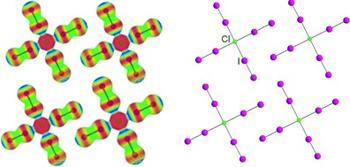Iodine–Iodine Bonding makes Tetra(diiodine)chloride, [Cl(I2)4]−, Planar
Christine Walbaum, Mark Richter, Ulf Sachs, Ingo Pantenburg, Sebastian Riedel, Anja-Verena Mudring, Gerd Meyer – 2013
Planar statt tetraedrisch! Das Polyinterhalogenid [Cl(I₂)₄]⁻, das in der Gasphase tetraedrisch wäre, nimmt in den Kristallen von [(H₅O₂)(I₂b15c5)₂][Cl(I₂)₄] eine planare Struktur ein (I₂b15c5=Diiodbenzo-15-Krone-5). Neben anderen Effekten wie elektrostatischer Anziehung zwischen kationischen und planaren anionischen Schichten spielen auch Iod-Iod-Bindungen mit σ-Loch-Wechselwirkungen eine wichtige Rolle.
The polyinterhalide [Cl(I₂)₄]⁻ is square‐planar in the crystal structure of [(H₅O₂)(I₂b15c5)₂][Cl(I₂)₄] (I₂b15c5=diiodobenzo‐15‐crown‐5), although it would be tetrahedral in the gas phase. Along with other effects, such as electrostatic attractions between the cationic and planar anionic layers, iodine–iodine bonding with σ‐hole interactions plays a considerable role is stabilizing the square‐planar configuration.

